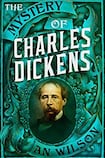
As his lengthy list of biographies is already peppered with the names of literary titans – CS Lewis, John Milton, Iris Murdoch – it seems natural that the highly prolific A.N. Wilson would take a shot at the life of one of the most intriguing and enduring writers of all time.
That we must look to the novels to find the real story of Dickens’s life is the central premise of Wilson’s examination. This goes beyond a mere reading of David Copperfield as fictionalised autobiography or the acceptance of Great Expectations as the more on-the-nose rendition. Wilson contends that evidence of even the most trivial aspects of his past, thoughts and attitudes are to be found in each of Dickens’s books.
“That is the reason that, if we look for the biographies of many of Dickens’s contemporaries, we look in their letters and diaries and in the reminiscences; but if we try to do the same for Dickens, we are always led back to the novels. His letters and the one remaining engagement diary, give us only hints. The full story is what he wrote out for us himself.”
Wilson renders Dickens’s life as a series of seven mysteries, citing the author’s fictional characters and situations as reflections of his real-life experiences. From the outset, when we meet a dying Dickens at his home at Gad’s Hill, we are plunged into Dickens’s extraordinary life with an account of his relationship with actress Nelly Ternan.
Wilson revels in exposing the double standards of the man and the times in which he lived
Only 18 when she and Dickens, 27 years her senior, began an adulterous affair that would last until his death 13 years later, the story of their liaison and the lengths to which Dickens went to cover it up, make for spicy reading. Rather than shying away from the seedier aspects of Dicken’s secret life, Wilson revels in exposing the double standards of the man and the times in which he lived.
Wilson casts a journalist’s eye over the case of “the cruel marriage”. Dickens’s nastiness towards Catherine, his wife of 22 years and mother of their 10 children, is not in doubt – he publicly denounced her as mentally unsound and an unfit mother with little evidence for either. However, Wilson builds a nuanced picture of the marriage and its breakdown, claiming that Dickens was fully aware of his own poor behaviour, and while bad marriages litter his books, so too do bad husbands – Jerry Cruncher in A Tale of Two Cities and Quilp in The Old Curiosity Shop.
Wilson focuses on the contradictory nature of Dickens’s character. The author established a refuge for fallen women while frequenting prostitutes and engaging in a passionate affair with a much younger woman.
As a charitable organiser, he reviled organised charity. “He hated systems of organised charity – the pointless charitable endeavours of Mrs Jellyby in Bleak House, the clumsy philanthropy of Honeythunder in The Mystery of Edwin Drood.”
Contradictions abound. He lauded kindness in his characters and championed the underdog, while abusing his wife and publicly condemning the outcry against the massacre, by Jamaica’s governor, of 600 black Jamaicans, claiming that they were not the same as “men in clean shirts in Camberwell”.
Dickens shone a light on life in 19th-century England. Wilson asserts that “It’s through Balzac, Tolstoy and Dickens that this age is rendered most clearly for us, rather than through journalism.” He was very much in touch with the realities of 19th-century life.
The Dickens family was not a wealthy one. He was put to work in a blacking factory at the age of 12, while his spendthrift father was imprisoned for unpaid debts in Marshalsea. Rather than blaming his father for the family’s new-found dire situation, Dickens hated his mother for it, Wilson says. Indeed, finding a decent mother figure in any of Dickens’s novels would be exceedingly difficult, whereas indebted father characters are painted as lovable rogues. Consider Micawber and Dorrit, in this context.
An exhilarating read for both Dickens aficionados and those who have only a passing familiarity with his work
While the book’s subject matter is fascinating and the research impressive, there are technical flaws – unnecessary reiteration of established facts and Wilson’s over-fondness for certain words. Who knew that “pantomimic” could be used so often in one book?
Faulty editorial decisions aside, this book will be an exhilarating read for both Dickens aficionados and those who have only a passing familiarity with his work. For the former, it’s a truly detailed examination of the author’s life, works and times. For the latter, the story of a strange and mysterious life led in the public eye may encourage the reading of Dickens’s work.











